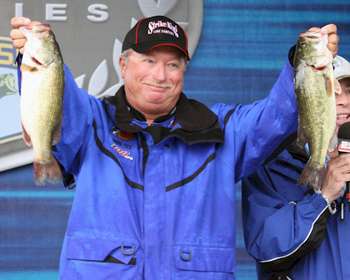
Flipping and pitching legend Denny Brauer has never seen a waterway or situation that didn't cry out for the big stick and a short line.
He recognizes there are times of the year when flipping may not be the dominant pattern. Still, look into his rod locker anytime he launches his boat, and there's a pretty good chance he'll have at least a couple of flipping and pitching rods at the ready, even during winter, when many other anglers put them away.
"What you have in the wintertime is a lot of fish going deep, so some people don't think that's the time to flip and pitch," the Missouri pro explains. "In some areas of the country, that's very true. There, you need to get down in those deeper zones where the fish are. " But there are times and places where, even during the coldest months, he'll break out the long rod.
"In the southern part of the country it can actually be one of the better times to flip, especially if you have any vegetation, and the bass are getting up under the mats," he says. What he's often looking for to make that happen is what otherwise would be considered a bad hand.
"It's really good after a cold front situation and in negative conditions when they get really stacked up under that kind of stuff. It can become the only way to catch those fish," he says.
In some lakes, especially those without vegetation, it may not be an option: "A lot of it is based on water clarity," Brauer says. "Some of the lakes are at their clearest in the winter, so the flipping technique pretty much goes out the window.
The pitching technique can still be in play, and you might have some limited opportunities when pitching can be good, but that's going to be concentrated more on the steeper banks." For example, on the highland lakes near his Missouri home, "it tends to be a lot of the chunk rock banks that may have a laydown log on them, anything that makes something a little different for the bass to hide in," explains Brauer. "You have to have deepwater access nearby.
In the wintertime, you need to really focus on main lake areas and fish the steeper targets where the bass have deep water access nearby." While the bite can get tougher during the winter, Brauer rarely turns to finesse techniques.
Drop shotting and fishing a tiny worm might be applicable if the water is exceptionally clear, or you just want to catch numbers or fill out a limit, but it rarely wins on the Tournament Trail. "In cold weather, I'm probably going to be fishing a 1/2-ounce Strike King Premier Pro Model Jig," he says.
But while the bait remains the same, he accessorizes it differently than he would in warmer water. "In winter, I like a natural color jig, like green pumpkin craw, and I'm probably going to use a chunk behind it, something that doesn't have a lot of action — the Denny Brauer chunk instead of the Rage Craw. I like the Rage Craw and the Rage Chunk in warm water, but in cold water you don't want a lot of action, so I'm really going to subdue the trailer and create a subtle presentation."
Keeping with that subtler action, he works the bait slowly, tempting lethargic bass to claim an easy meal. Sometimes it's not a fast technique. When he gets to a prime piece of cover, he works it thoroughly and waits for the fish to warm up to the idea of eating.
"In the wintertime, I get a higher percentage of bites when my bait is resting on the bottom," he concludes. "The rest of the year I'd say 70 to 80 percent of the bites come when the bait is falling, but in the wintertime, they're a little more sluggish. You have to slow down and work for the bites."
Originally published Jan. 2011





